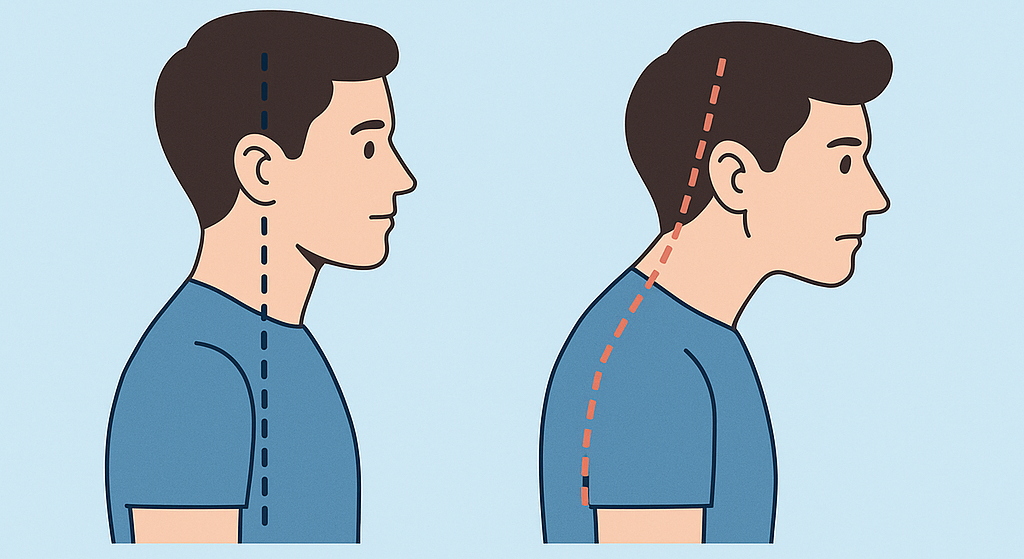Do you ever catch yourself hunched over your phone or laptop? Forward head posture, also known as tech neck, is one of the most common posture problems today. It doesn’t just look bad — it can lead to neck pain, headaches, and even impact your breathing and mood.
The good news? You can fix forward head posture with a few simple steps that don’t require expensive equipment or complicated routines. In this guide, we’ll cover five actionable ways to improve your posture starting today.
1. Awareness – Check Your Posture
The first step to fixing forward head posture is knowing how you currently stand or sit. Many people aren’t even aware they’ve developed poor posture habits.
Try standing sideways in front of a mirror or taking a side-profile photo. Notice if your ears are positioned in front of your shoulders — that’s a sign of forward head posture.
You can also use posture tracking tools like the HeadUp App to monitor your posture automatically throughout the day. With real-time posture tracking, you’ll get notified whenever you start slouching, so you can correct it immediately.
2. Strengthen Neck and Upper Back Muscles
Forward head posture is often caused by weak neck and upper back muscles. Strengthening these areas helps pull your head back into alignment.
Here are two simple exercises to start:
- Chin Tucks: Sit or stand upright. Gently pull your chin straight back (not down), creating a “double chin” effect. Hold for 5 seconds and repeat 10 times.
- Wall Angels: Stand with your back against a wall, feet a few inches away. Keep your lower back, upper back, and head touching the wall. Slowly raise and lower your arms like making a snow angel, keeping them in contact with the wall. Repeat 10 times.
3. Stretch Tight Chest Muscles
When your head moves forward, your chest muscles tend to tighten. Stretching these muscles helps open up your chest and makes it easier to maintain upright posture.
Try this stretch:
- Doorway Stretch: Stand in a doorway with your arms bent 90 degrees and forearms resting on the doorframe. Step forward gently until you feel a stretch in your chest. Hold for 20–30 seconds and repeat 2–3 times.
Foam rolling your chest area can also help release tight muscles.
4. Fix Your Workspace Ergonomics
Even with exercises and stretches, poor ergonomics will keep pulling your head forward. Make sure your workspace supports good posture.
Quick tips:
- Keep your monitor at eye level so you’re not looking down.
- Use a laptop stand if working on a laptop.
- Sit with your feet flat on the floor and your shoulders relaxed.
- Avoid leaning forward or slouching.
A few small adjustments can prevent posture strain during long hours at your desk.
5. Use Reminders and Posture Alerts
Finally, the key to long-term improvement is consistency. Even with the best intentions, it’s easy to forget to check your posture throughout a busy day.
Set phone alarms, sticky notes, or calendar reminders to check in on your posture. Or even better, try an app that automatically alerts you when you start slouching.
The HeadUp App uses the motion sensors in your AirPods to detect poor posture and gently notify you in real time. It’s like having a posture coach in your ear, keeping you on track without constant manual checking.
Conclusion
Forward head posture doesn’t have to be your new normal. With a few daily exercises, stretches, ergonomic tweaks, and helpful reminders, you can stand tall again and prevent pain down the road.
Want an easier way to stay on top of your posture? Check out the HeadUp App — your invisible posture coach that keeps you aligned, effortlessly.
Disclaimer: This post is for informational purposes only and does not replace professional medical advice. Consult a healthcare professional if you experience persistent pain or discomfort.
